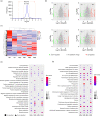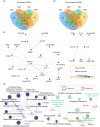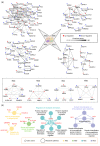Proteomic characterization of four subtypes of M2 macrophages derived from human THP-1 cells
- PMID: 35557041
- PMCID: PMC9110321
- DOI: 10.1631/jzus.B2100930
Proteomic characterization of four subtypes of M2 macrophages derived from human THP-1 cells
Abstract
Macrophages are widely distributed immune cells that contribute to tissue homeostasis. Human THP-1 cells have been widely used in various macrophage-associated studies, especially those involving pro-inflammatory M1 and anti-inflammatory M2 phenotypes. However, the molecular characterization of four M2 subtypes (M2a, M2b, M2c, and M2d) derived from THP-1 has not been fully investigated. In this study, we systematically analyzed the protein expression profiles of human THP-1-derived macrophages (M0, M1, M2a, M2b, M2c, and M2d) using quantitative proteomics approaches. The commonly and specially regulated proteins of the four M2 subtypes and their potential biological functions were further investigated. The results showed that M2a and M2b, and M2c and M2d have very similar protein expression profiles. These data could serve as an important resource for studies of macrophages using THP-1 cells, and provide a reference to distinguish different M2 subtypes in macrophage-associated diseases for subsequent clinical research.
Keywords: Biological function; M2 subtype; Macrophage; Proteomics; THP-1 cells.
Figures






Similar articles
-
Dissection of pro-tumoral macrophage subtypes and immunosuppressive cells participating in M2 polarization.Inflamm Res. 2024 Sep;73(9):1411-1423. doi: 10.1007/s00011-024-01907-3. Epub 2024 Jun 27. Inflamm Res. 2024. PMID: 38935134 Free PMC article. Review.
-
Primary Human M2 Macrophage Subtypes Are Distinguishable by Aqueous Metabolite Profiles.Int J Mol Sci. 2024 Feb 18;25(4):2407. doi: 10.3390/ijms25042407. Int J Mol Sci. 2024. PMID: 38397084 Free PMC article.
-
Interleukin-27-polarized HIV-resistant M2 macrophages are a novel subtype of macrophages that express distinct antiviral gene profiles in individual cells: implication for the antiviral effect via different mechanisms in the individual cell-dependent manner.Front Immunol. 2025 Mar 10;16:1550699. doi: 10.3389/fimmu.2025.1550699. eCollection 2025. Front Immunol. 2025. PMID: 40129989 Free PMC article.
-
Comparative Proteomic Analysis of Polarized Human THP-1 and Mouse RAW264.7 Macrophages.Front Immunol. 2021 Jun 29;12:700009. doi: 10.3389/fimmu.2021.700009. eCollection 2021. Front Immunol. 2021. PMID: 34267761 Free PMC article.
-
Regulation of macrophage polarization by targeted metabolic reprogramming for the treatment of lupus nephritis.Mol Med. 2024 Jun 25;30(1):96. doi: 10.1186/s10020-024-00866-z. Mol Med. 2024. PMID: 38914953 Free PMC article. Review.
Cited by
-
Macrophage Polarization and the Regulation of Bone Immunity in Bone Homeostasis.J Inflamm Res. 2023 Aug 22;16:3563-3580. doi: 10.2147/JIR.S423819. eCollection 2023. J Inflamm Res. 2023. PMID: 37636272 Free PMC article. Review.
-
Immune and metabolic cross-links in the pathogenesis of comorbid non-alcoholic fatty liver disease.World J Gastroenterol. 2023 Jan 28;29(4):597-615. doi: 10.3748/wjg.v29.i4.597. World J Gastroenterol. 2023. PMID: 36742172 Free PMC article. Review.
-
Dissection of pro-tumoral macrophage subtypes and immunosuppressive cells participating in M2 polarization.Inflamm Res. 2024 Sep;73(9):1411-1423. doi: 10.1007/s00011-024-01907-3. Epub 2024 Jun 27. Inflamm Res. 2024. PMID: 38935134 Free PMC article. Review.
-
Effects of bone surface topography and chemistry on macrophage polarization.Sci Rep. 2024 Jun 3;14(1):12721. doi: 10.1038/s41598-024-62484-3. Sci Rep. 2024. PMID: 38830871 Free PMC article.
-
Mendelian randomization reveals interactions of the blood proteome and immunome in mitral valve prolapse.Commun Med (Lond). 2024 Jun 6;4(1):108. doi: 10.1038/s43856-024-00530-x. Commun Med (Lond). 2024. PMID: 38844506 Free PMC article.
References
MeSH terms
Grants and funding
LinkOut - more resources
Full Text Sources
Molecular Biology Databases

